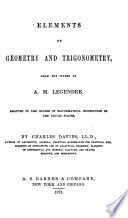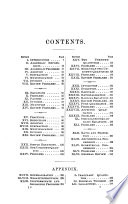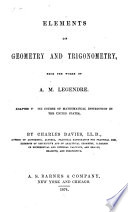 | Charles Davies - Geometry - 1872 - 464 pages
...spherical trigonometry. b TRIGONOMETRY AND MENSURATION. INTR0DUCTI0N T0 TRIG0N0METRY. LOGARITHMS. 1. THB LOGARITHM of a number is the exponent of the power to which it is necessary to raise a fixed number, to produce the given number. The fixed number is called the base of the system. Any... | |
 | Charles Davies, William Guy Peck - Mathematics - 1872 - 602 pages
...book, called the log-book. [Gr. ioyor, ratio, and The logarithm of a LOG'A-RITHM apiaftoc, number], number is the exponent of the power to which it is necessary to raise a fixed number, called the base, to produce the given number. If we suppose a to preserve a constant... | |
 | Elias Loomis - Algebra - 1873 - 396 pages
...seven decimal places. 2.4 2.4.9 ' ' 5.16 5.10.168 5.10.15.163 = 1.9743506. CHAPTEE XX. LOGARITHMS. 394. The logarithm of a number is the exponent of the power to which a constant number must be raised in order to be equal to the proposed number. The constant number is... | |
 | Daniel Barnard Hagar - Algebra - 1873 - 278 pages
...Find the square of a - b+y. Ans. a? 3. Find the square of a — b — c. SECTION Lll. LOGARITHMS. 391. The Logarithm of a number is the exponent of the power to which a constant number must be involved to produce the given number. Thus, if 8 is the constant number,... | |
 | Charles Davies - 1874 - 464 pages
...spherical trigonometry. TRIGONOMETRY AND MENSURATION. INTRODUCTION TO TRIGONOMETRY. LOGARITHMS. 1. TUB LOGARITHM of a number is the exponent of the power to which it is necessary to raise a fixed number, to produce the given number. The fixed number is called the base of the system. Any... | |
 | Adrien Marie Legendre - Geometry - 1874 - 500 pages
...0 INTRODUCTION TO TRIG( LOGARITHMS. rYORK ASTOR, LENOX AND TILDE* FOUNDATIONS 1899 1. THE LOGAEITHM of a number is the exponent of the power to which it is necessary to raise a fixed number, to produce the given number. The fixed number is called the base of the system. Any... | |
 | Charles Davies - Algebra - 1875 - 318 pages
...corresponding number by Jf, 10™ = M. Thus, if we make m — 0, Jkf will be equal to 1 ; if m = 1, M will be equal to 10, &c. Hence, The logarithm of a number is the exponent of the poioer to which it is necessary to raise the base of the system in order to produce the number. 217.... | |
 | William Guy Peck - Algebra - 1875 - 348 pages
...I 4 ___ 1 p 1 ' 3(ж — 2) — 2(ж — 1) + 6(ж + 1)' CHAPTER XI. LOGARITHMS. Definitions. 185. The logarithm of a number is the exponent of the power to which it is necessary to raise a fixed number to produce the given number. The fixed number is called the base of the system. 186.... | |
 | Carl Bremiker - Logarithms - 1875 - 544 pages
...common logarithm of a number (which kind of logarithms is exclusively used for purposes of computation) is the exponent of the power to which it is necessary to raise the number 10 in order to produce the given number. Thus, if the exponents are a and I, and if we put 10"... | |
 | William Guy Peck - Conic sections - 1876 - 412 pages
...proved. TRIGONOMETRY. I. INTRODUCTION— USE OF LOGARITHMS. DEFINITIONS AND EXPLANATIONS. 1. The common logarithm of a number is the exponent of the power to which it is necessary to raise 10 to produce the given number ; thus, 2 is the logarithm of 100, because 102 = 100. NOTE. — The... | |
| |